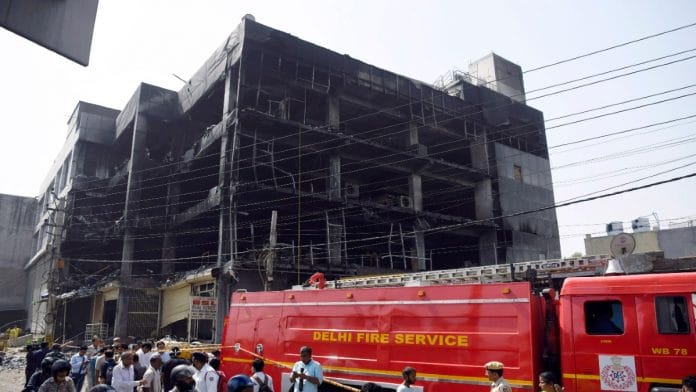The fire in the four-storey building in Delhi’s Mundka on 13 May, which killed 27 people, will be seen as an accident, but those responsible for the tragedy must be held to account. Why didn’t the people desperately leaping out of the floors use the fire exits? Because the building only had one, when every building should have minimum of two exits. The building also didn’t have a ‘no objection certificate’ from the fire department.
And so, the blame game began with political parties at their accusing best. Although the owner of the ill-fated building has been arrested, has anything been done to arrest future tragedies?
No! The right to life cannot be so easily extinguished.
State’s negligence
It’s not just the owner who is culpable; the State is even more to blame. In fact, the buck stops with the State — for neglecting its fundamental duty of safeguarding peoples’ lives. ‘Nero fiddling’ is nothing to this kind of State apathy. The State’s agencies are caught napping. The fire department, for not objecting to fire-risk constructions; the Municipal Corporation of Delhi (MCD) for allowing such unlawful structures to exist.
The MCD, instead of doing its duty in sheltering citizens and the city’s buildings, was busy mapping out ‘select’ areas, razing the homes and lives of the vulnerable and underprivileged (largely minorities).
Isn’t it ironic that the State should storm into action, arm itself with bulldozers, and bring down alleged ‘illegal encroachments’ of the defenceless, when it is the State’s constitutional duty (reinforced by a litany of Supreme Court judgments) to provide shelter to the weaker sections of society; and not encroach upon their right to life, by rendering them homeless?
How much more appropriate would it be for the State to busy itself in checking the criminal activities of lawless builders and the like, marshalling the bulldozers to dismantle the wickedly illegal and fiery death traps? Instead, we have the State squandering its immense powers on outlandish issues.
Also read: No emergency exit, fire extinguishers — how ‘illegal’ building in Delhi’s Mundka turned death trap
Twisted priorities
Political parties, rather than taking the lead in ensuring the right to life, to see that every high-rise building has an alternate stairway, are busy with bizarre subjects, questioning the past.
What’s inside the locked rooms of the Taj Mahal? Does the monument have ‘secret chambers’ full of Hindu idols? Shouldn’t the Qutub Minar get a name change? Is there a temple beneath a mosque? How can we set right the atrocities committed by Aurangzeb? Yes, the Mughal King was a horrendous tyrant who razed temples and plundered the citizens. But does this mean that we pull down every mosque and cause conflict in society and pain to innocent citizens?
The Places of Worship Act, 1991 was enacted for this very reason — to preserve the status quo, to maintain harmony, to ensure that every place of worship stands undisturbed.
Burning issue
How can the State neglect its legitimate duty — guarantee the basic fundamental rights to the citizens? How can it stand by and watch people burn to death, all for the lack of elementary and compulsory fire-protection measures?
All that the State had to do was check if high-rise buildings were properly certified. To conduct a survey and zealously see to it that every building is fire-proof.
Instead, the State engages in the strident calls for inspection of places of worship — and makes grandiose plans for more such spiritual assessments.
Then we have the much touted ‘Delhi Model’ of governance, proudly proclaimed as proof of ‘people-centric’ political practice. But when it comes to people’s ‘security’, it is sadly found lacking. It is not fireproof.
Should this kind of indifference with regard to the welfare of people be a role model for the rest of the country?
Also read: How brave crane operators battled smoke & flames to save 50 women from deadly Mundka fire
Does govt care?
We cannot allow the famed Indian principle of ‘tolerance’ to let this Delhi fire tragedy go unaccounted for and not lead to any meaningful change in how buildings are inspected.
How much more time will the State waste in matters that are needless and polarising? How many more people must die from State callousness before corrective steps are taken?
This should be a clarion call to the State and its agencies — to concentrate their energies on meaningful governance, to provide food, water, shelter, to generate livelihoods, and most important of all, to ensure the protection of citizens.
If we are trapped in a blazing building, at death’s doorstep, we do not care if the Taj Mahal has secret chambers, if there is a temple beneath a mosque, if the Qutub Minar needs renaming. All that we want then is an escape route to safety – an alternate set of stairs. A right to live.
Mina Anand is a lawyer. She tweets @minacricket. Views are personal.
(Edited by Prashant)






